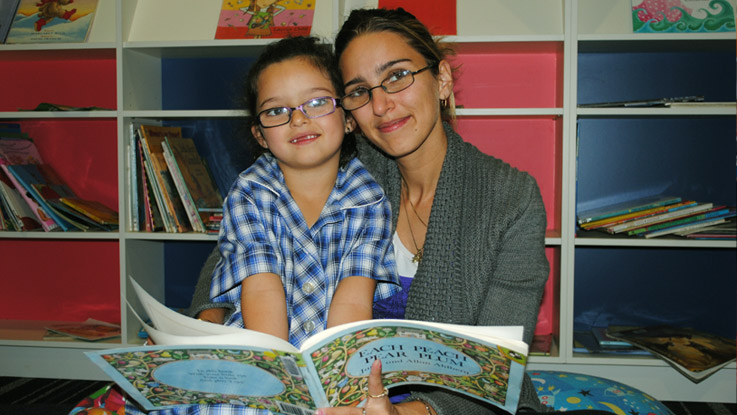
New report: Disadvantaged Australian girls ‘starting behind and staying behind’ in school and careers
The large gap between the education and post-school performance of disadvantaged Australian girls and young women compared to their well-off peers – uncovered in a new report published today – is a threat to the nation’s prosperity and social fairness according to The Smith Family.
The national charity said the results – contained in the COAG Reform Council’s latest education report Tracking equity: Comparing outcomes for women and girls in Australia – showed disadvantaged girls were being left behind while their more advantaged peers were doing better at school and attaining higher qualifications in greater numbers.
National results include:
- Across reading, writing and numeracy, girls from disadvantaged backgrounds tested well below girls from well-off backgrounds. In Year 3 reading the gap between the two groups was 91.8 points Australia-wide.
- The gap in Year 12 attainment between young women from low and high socio-economic backgrounds is 19.3 per cent.
- In 2011, only 53.6 per cent of 17-24 year old women in the most disadvantaged areas were fully engaged in work and/or study after leaving school compared to 82.1 per cent in the most advantaged areas – a gap of nearly 30 per cent (the difference among men between the two groups is 20.1 per cent).
The Smith Family’s CEO, Dr Lisa O’Brien, said on current trends Australia would inherit a generation of young women in parts of the country without the education or skills to prepare them to fully contribute to our society.
“It’s clear from the report that girls from disadvantaged backgrounds are starting school behind and then staying behind – not just throughout their schooling – but also into post-school life,” said Dr O’Brien.
“This has enormous implications for us as a country. If we want a prosperous, socially cohesive nation then we can’t let large numbers of our citizens fall behind like this.
“I’m particularly concerned about what the results tell us about young women in their post-school lives.
“Generally young Australian women are already less likely to transition to full engagement in work or study than their male counterparts, but when financial and social barriers are brought into play, vulnerable young women become doubly disadvantaged.
“And for all women graduates – not just those from disadvantaged backgrounds – the stark reality is that when they do enter the workforce the pay disadvantage with men starts immediately.
“Even accounting for differences in hours worked, the gap between men and women graduates’ starting wages is $1872 annually.
“This is a real issue of social fairness. If we believe in gender equality – in salaries, in the equal representation of women in senior leadership roles and among our political representatives, all areas where women are behind men – then we must start by making sure the most vulnerable girls and young women in our community are getting the education they need.
“We’re never going to get there if we can’t get the building blocks right; if a large pocket of young disadvantaged women aren’t able to read properly or find anything beyond low skilled work when they leave school – a very unlikely proposition given the way our economy is changing.
“Looking to turn these results around, it’s a case of making sure our resources go towards the right programs or approaches that are delivering results.
“The Smith Family has a program we run in one Alice Springs school – Girls at the Centre – which has been evaluated independently and found to have improved retention and attendance and had a positive impact on the girls’ life goals and the school-engagement of them and their families.
“With Indigenous girls at risk of poorer school attendance and leaving school early, Girls at the Centre motivates and supports girls from Years 7 to 9 to stay at school, broadens their aspirations and boosts educational achievement.
“The girls have dedicated ‘coaches’, plus access to a range of sports, arts, lifestyle and personal development activities to support them at school.
“As a result of Girls at the Centre, participants have a 10% higher average school attendance rate compared to other female students in the same school.
“And as we know, attendance is a crucial indicator in terms of educational performance and achievement.
“We believe Girls at the Centre is a model that could be used in other disadvantaged schools to improve the performance of girls and young women.
“We know what works, it’s time to start looking at ways to scale up and expand the programs that make a difference to get better educational outcomes for vulnerable Australian girls and young women.
“We also support the Reform Council’s recommendation that COAG agree to regular performance reporting on gender outcomes against national reform areas,” said Dr O’Brien.
Media contact: Paul Andrews 0409 665 495
Media contacts:
Andrew Dickson | National Media Manager (National) - 0421 285 529 | andrew.dickson@thesmithfamily.com.au
Carla Horton | Senior Media Advisor (QLD & WA) - 0423 618 776 | carla.horton@thesmithfamily.com.au
Reid Jermyn | Media Advisor (VIC, SA & NT) - 0412 803 566 | reid.jermyn@thesmithfamily.com.au
Ben Chenoweth | Senior Media Advisor (NSW, ACT & TAS) - 0413 346 934 | ben.chenoweth@thesmithfamily.com.au
The Smith Family is a national children’s education charity that helps young Australians experiencing disadvantage to create better futures for themselves through harnessing the power of education. We partner with around 800 Australian schools and work with over 162,000 children and young people experiencing disadvantage access our education support programs to help them overcome . For more information, visit thesmithfamily.com.au
